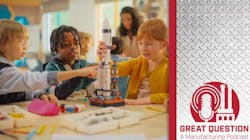Podcast: Manufacturing's future depends on industry reaching students
Megan Barrett is director of operations at Engineering Tomorrow. She has over 20 years combined experience in the fields of education and nonprofit management. Michael Gretczko is Deloitte’s chief business architect. In his 20-plus-year career, he has helped clients find solutions to their most pressing business issues. David Hook is an R&D engineer at CoorsTek Inc. He's been with the company for more than nine years and works on new material formulations. The three recently spoke with Anna Smith, news editor for IndustryWeek, a sister brand to Smart Industry, about the latest efforts to introduce students to the STEM fields and careers in manufacturing.
Below is an excerpt from the podcast:
IndustryWeek: Why does your company or nonprofit have the desire to encourage interest in STEM fields, especially for middle and high schoolers?
See also: Podcast: Lean manufacturing Q&A—Industry pros review their wins
Michael Gretczko: I'm happy to start. I'm sure we'll all have different reasons why we're focused on it. We're really focused on maybe three questions: why we focused on STEM, why diverse students in particular, and then why middle school and high school. So, why STEM? When we look at the manufacturing talent marketplace, our research suggests that over the next eight to 10 years, there's going to be something like 1.9 million jobs that are going to go unfilled in the manufacturing space as a result of a lack of STEM-fluent talent. That's a huge challenge for our clients who are manufacturers. And we think we've got a real responsibility to help encourage students to pursue very promising and rewarding careers in this space.
Why diversity? Why do we focus on underserved communities? When you look at the STEM workforce, it's particularly underrepresented by females. The workforce is something like 65% male, and it's underrepresented by non-white folks, something like 23%. And what we've learned in everything that we do is diverse teams solve really hard problems much more effectively, so we think it's important that that workforce is diverse.
See also: Preventing workplace violence starts with a plan
And lastly, why do we focus on middle school and high school? What we found also in our research with some of our educational partners is the moment when students start to make a decision about their career, they want to pursue the realm of career possibilities that are out there, that really happens in middle school. So we try to drive awareness around these career paths in the middle school area. And then travel with those children as they move through middle school and high school. So, as they start to make choices around higher education and their ultimate employment in the workforce, they see STEM as a path that they could pursue.
Megan Barrett: I agree with Michael's comments. We need to reach students in high school before they choose colleges and majors to make sure they're aware of the amazing careers an engineering degree affords them. The bottom line is the world needs more engineers and engineers at all levels to solve global challenges like climate change, health and disease control, water availability and reuse. The majority of engineering- and R&D-focused companies report talent gaps, and without rapid interventions, these gaps will only widen as Baby Boomers retire.
See also: Retraining your best people, upskilling new hires through free virtual education
That said, an increase in numbers alone won't be enough. We need a greater diversity of perspectives to ensure more informed decision making for our organizations. In particular, we are led primarily by engineers, including Bill Woodburn, who founded the organization and is the former CEO of GE Infrastructure and a co-founding partner of Global Infrastructure Partners. Bill and our team of engineers have experienced the joy and fulfillment of careers in engineering, and they have a genuine desire to steward the next generation of engineers.
David Hook: My comments are related to pretty much all of that. The difference, maybe, is that our effort in sponsoring the science fair is sort of hyper local. We've been around for over 100 years, and we just realized that if we want to be around for the next 100 years, we need to be investing in the community in which we are based. I mean, we're based all across the nation as well, but we have a huge presence in the Denver metro area. So, supporting kids that really feel strongly that they want to go down this path, and the student that wants to do a science fair project as extra credit is already, you know, a student you want to see in your applicant pool. And then also just putting our own name out there a little bit. The fact that our logo is all over that science fair hopefully helps the students consider when they're ready to apply somewhere after they finish college. They might remember us fondly and remember that we do cool things and hopefully reach out to look for a job. That's what we're hoping for.
About the Podcast
Great Question: A Manufacturing Podcast offers news and information for the people who make, store, and move things and those who manage and maintain the facilities where that work gets done. Manufacturers from chemical producers to automakers to machine shops can listen for critical insights into the technologies, economic conditions, and best practices that can influence how to best run facilities to reach operational excellence.
About the Author
Scott Achelpohl
Head of Content
I've come to Smart Industry after stints in business-to-business journalism covering U.S. trucking and transportation for FleetOwner, a sister website and magazine of SI’s at Endeavor Business Media, and branches of the U.S. military for Navy League of the United States. I'm a graduate of the University of Kansas and the William Allen White School of Journalism with many years of media experience inside and outside B2B journalism. I'm a wordsmith by nature, and I edit Smart Industry and report and write all kinds of news and interactive media on the digital transformation of manufacturing.

